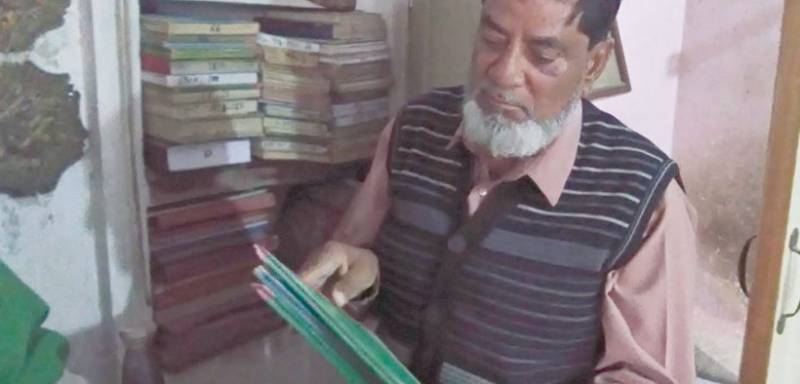
Gulzar Ahmad Ghauri recently passed away in Bahawalpur at the age of 73. He was an archivist, an avid collector who devoted his life to building archives in his modest home inside the walled city. Ghauri inherited the hobby of collecting old coins, pictures etc. from his father and made it into a life-long passion.
Ghauri started collecting pictures when he was 14 and at that time he would cut out pictures from newspapers and magazines. Later he started hunting for historical pictures of Bahawalpur and everything related to its rich history – coins, books, earthen pottery, uniforms of the army and police of the erstwhile Bahawalpur state, military badges among other memorabilia.
His family has been living inside the walled city for centuries and thus Bahawalpur’s love was embedded in his DNA. He collected more than three thousand books on Bahawalpur history in many languages -English, Urdu. Persian etc. He boasted of a history book on Bahawalpur written by Lala Daulat Ram that was published way back in 1825 in Delhi. He was quite open to sharing his books with students and researchers initially but later changed his mind when many people didn’t care to return books which he lent them. Ghauri had countless albums of rare pictures related to the city. Although he never counted but he guessed that there were more than ten thousand rare pictures in his collection.
Later, Ghauri donated his pictures to the city museum when it was established and also gifted them to a few officials in the city. He was in the good books of the scion of the Abbasid Dynasty, Nawab Salahuddin Abbasi who generously gifted him some of the pictures and artifacts for Ghauri’s collection. His modest home in Ahmadpuri gate was not adequate for his treasure but he did manage to preserve it there for decades.
Such was his passion, that Ghauri invested substantive amount of his money and energy in acquiring pictures, documents and books. No wonder he was rather sensitive about his mammoth collection. When Islamia University Bahawalpur offered to give space to his collection in their premises, he declined the offer as he was unsure about how the collection would be treated in a public sector institution. He hoped that one of his son would carry on the family legacy of preserving the collection.
Once I was having tea with him when a research scholar from UK offered him that his collection might be digitized by some prestigious university, he answer was a resounding ‘no’. A man of few words, Gulzar Ghauri was a long time acquaintance as I covered him few years back for a Lahore based newspaper. I used to visit him once in a while and was fortunate enough to see some of his albums and rare books stuffed into dingy rooms in his upper storey home. For quite some time, he was indisposed and few days ago he breathed his last.
In a small city like Bahawalpur, a collector like Gulzar Ghuari is a rarity.
One hopes that his son would try to follow the tradition of his father. Or will the district administration (deputy commissioner, and commissioner) do something to preserve the treasure an assiduous son of the city collected so painstakingly? Let’s hope this is done sooner than later.
Ghauri started collecting pictures when he was 14 and at that time he would cut out pictures from newspapers and magazines. Later he started hunting for historical pictures of Bahawalpur and everything related to its rich history – coins, books, earthen pottery, uniforms of the army and police of the erstwhile Bahawalpur state, military badges among other memorabilia.
His family has been living inside the walled city for centuries and thus Bahawalpur’s love was embedded in his DNA. He collected more than three thousand books on Bahawalpur history in many languages -English, Urdu. Persian etc. He boasted of a history book on Bahawalpur written by Lala Daulat Ram that was published way back in 1825 in Delhi. He was quite open to sharing his books with students and researchers initially but later changed his mind when many people didn’t care to return books which he lent them. Ghauri had countless albums of rare pictures related to the city. Although he never counted but he guessed that there were more than ten thousand rare pictures in his collection.
Later, Ghauri donated his pictures to the city museum when it was established and also gifted them to a few officials in the city. He was in the good books of the scion of the Abbasid Dynasty, Nawab Salahuddin Abbasi who generously gifted him some of the pictures and artifacts for Ghauri’s collection. His modest home in Ahmadpuri gate was not adequate for his treasure but he did manage to preserve it there for decades.
Such was his passion, that Ghauri invested substantive amount of his money and energy in acquiring pictures, documents and books. No wonder he was rather sensitive about his mammoth collection. When Islamia University Bahawalpur offered to give space to his collection in their premises, he declined the offer as he was unsure about how the collection would be treated in a public sector institution. He hoped that one of his son would carry on the family legacy of preserving the collection.
Once I was having tea with him when a research scholar from UK offered him that his collection might be digitized by some prestigious university, he answer was a resounding ‘no’. A man of few words, Gulzar Ghauri was a long time acquaintance as I covered him few years back for a Lahore based newspaper. I used to visit him once in a while and was fortunate enough to see some of his albums and rare books stuffed into dingy rooms in his upper storey home. For quite some time, he was indisposed and few days ago he breathed his last.
In a small city like Bahawalpur, a collector like Gulzar Ghuari is a rarity.
One hopes that his son would try to follow the tradition of his father. Or will the district administration (deputy commissioner, and commissioner) do something to preserve the treasure an assiduous son of the city collected so painstakingly? Let’s hope this is done sooner than later.

